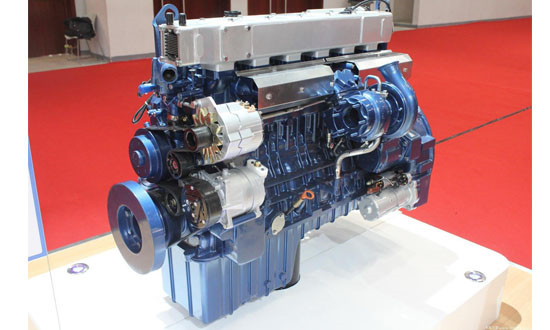This article mainly analyzes the causes of engine intake and exhaust system failures,mainly in 6 aspects as below.
1.Air Cleaning:Failures such as cylinder scoring,supercharger damage and increased smoke etc. are related to air quality and cleanliness.
1)Dust and dirt sucked into the cylinder will damage the cylinder and piston of engine,as well as the valve stem,guide rod and the blades of the supercharger compressor.And damage to the supercharger blades will cause the imbalance of supercharger,resulting in bearing damage.
2)Sometimes the air filter is qualified, but the air intake line is not tightly sealed or cracks can also cause the engine to suck dirty air.
2.Air resistance: intake resistance increasing leads to excessive smoke exhaust and power reducing.
1)If the air resistance of the intake line is too large,the air flow will be reduced and the air-fuel ratio will be changed,thus the engine power is reduced, and the smoke from the engine exhaust will increase.
2)In addition to visually inspecting the pipe joints whether there is cracks and looseness,you can also use soapy water to the air-to-air cooler,the connector,and the sealing surface of the manifold cover to check for leaks.
3.Excessive exhaust resistance-one of the power reduction reasons.
1)We can’t ignore the exhaust resistance is an important reason for the engine power decline.
2)If the exhaust flow is not smooth, the turbocharger cannot work effectively.
3)Using exhaust braking has an effect on the operation of supercharger,so too much smoke is exhausted when using exhaust brake.

4.Failure of the supercharger--oil consumption and leakage:
Engine oil is used to lubricate bearings and partially cool the supercharger.The oil is supplied to the supercharger through the oil supply line under the working pressure of the engine.The oil returns to the engine oil pan through the oil return pipe at the bottom of the supercharger.Seals are used at each end of the turbocharger rotor assembly,the main function of the sealing ring is to prevent exhaust gas or pressurized air from entering turbocharger housing.The possibility of oil leakage at the sealing ring is very small,but it can also happen.
1)If the pressure of oil pan is too high,it is difficult to return the oil from supercharger,which will increase the load on the bearing seat and cause the oil to leak from the compressor seals.
2)If the oil return pipe is blocked or damaged,it will cause the pressure increasing of the supercharger housing, which will cause the oil to overflow from the seals.
3)If the intake or exhaust resistance is too high, a vacuum will be formed between compressor and supercharger housing,causing oil to leak through the seals.
4)In order to check whether there is oil leak through seals,remove the exhaust pipe and the crossover pipe,and then check the turbine housing and the crossover pipe for lubrication oil.
5.Supercharger exhaust gas actuator (bypass super charger)-function check.
1)If the supercharger is a bypass supercharger, visually check the wear of the rod pin,whether the hose is cracked, whether the actuator rod and control rod are bent, etc.
2)To confirm whether the bypass is working,you can do the functional check. Connect a regulated air source and an accurate pressure gauge to the capsule. Pressurized 180kPa,the control rod will move about 5mm.
3)There should be no stuck or air leaking. If the control rod does not move, it should be replaced.
6.Air to air cooler-Fault reason analysis:Large resistance and leakage of air to air cooler is one of the reasons that cause the decrease of engine power and smoke increasing.The inspection method is as follows:
1)Intercooler pressure drop check: Measure the pressure drop of the air-to-air cooler system with a mercury manometer as follows:Install one end of the manometer into the 1/8 inch pipe thread at the outlet bend of the compressor, Install the other end of the pressure gauge to the 1/8-inch thread of the intake manifold.Running the engine at specified higher power and corresponding speed,and recording the pressure gauge changes.If the pressure difference is greater than 156mmHg or 21kPa,check whether the intercooler and associated piping are blocked, clean and replace them if necessary.
2)Intercooler air leak check: install a pipe plug or cover at the intercooler outlet,install the pressure gauge, air supply pipe and air pressure regulator at cooler inlet,and apply 207kPa air pressure to the cooler , turn off the air pressure regulator,observe the pressure gauge,if the pressure drops is within 49kPa within 15 seconds,the cooler is normal.If it is exceeded,then confirm whether the pressure drop is caused by intercooler leakage or pipe joint leakage. Apply soapy water to the pipe joint and observe whether bubbles appear.
3)If it is caused by the pipe joint,repair or replace the pipe joint and retest.If it's an intercooler leak,repeat the test three times to verify the accuracy of the pressure drop in order to determine the repair or replacement of the intercooler.
For the engine intake and exhaust system parts,such as air filter,engine seals,gasket,supercharger,turbocharger etc.,welcome to contact us.admin1@hnjingfu.com,wechat/whatsapp:+86 18137786577.
Authorized wholesaler,100% Genuine Parts ;
Foucsed on commercial vehicle parts more than 10 years;
Get reply within 24h;
Door to door delivery and OEM service is avaliable.
Contact and Get Price Now!